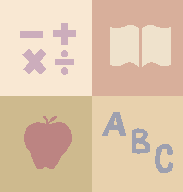 ◄Home
Why do we need to change?►
◄Home
Why do we need to change?►
 ◄Home
Why do we need to change?►
◄Home
Why do we need to change?►
The way we were...
Prior to taking this course, my experience as a student and teacher were limited to a traditional classroom environment with the teacher at the front of the class transmitting the information that was carefully planned for the day. Students sat quietly, speaking only in response to questions or after raising their hand and being acknowledged by the teacher. The goal of the learning environment was to establish discipline, order and structure.
This was during the Industrial Age where the purpose of education was to provide the 3 "Rs" (reading, 'riting, and 'rithmetic), the basic skills the learner needed to enter the workplace and train for his actual job. In "Everything You Learned in School," a web document by Dr. Rodney Riegle, Professor of Education at Illinois State University, he states that during the Industrial Age, the goals of education as well as the expectation of employers were "attitudes and abilities like trainability, obedience, punctuality, dependability, and loyalty."
Math was my field of study and, as far as I was concerned, the linear flow of information and activities perfectly met the goals and needs of all involved. The lesson plans and activities of the math class were designed according to the principles of cognitive information processing. Typically, math teachers provided both visual and auditory sensory input by demonstrating math problems on the blackboard while verbally explaining each step. In order to gain and hold students' attention, the teacher would randomly call upon students to help solve the problems. To reinforce the lesson, practice problems were assigned for rehearsal to ensure that the skills progressed from short-term memory to storage in long-term memory. As my seventh grade math teacher constantly remarked, "Repetition is the mother of study." Students were usually given time at the end of the formal lecture to begin their assignments. This allowed the teacher to observe the students' work and to provide help individually, if necessary. As Marcy P. Driscoll states in her Psychology of Learning for Instruction (2000), "...automaticity of basic skills is a desirable educational goal, and extensive practice is one of the ways to help achieve it" (p. 107). When more complex problems were taught, encoding occurred as new information was related to the previously learned concepts.
To demonstrate the practical application of math in real-world situations, word problems were included with the lesson or homework. They were usually met with dread because it was difficult for students to transfer the learned skills to solving the situational problem. Driscoll (2000) explains that when the learner is given a problem that relates to a situation he has experienced, he has developed schemata that helps him know how to solve the problem. However, many of the text book word problems presented situations that were unfamiliar to the learners and they were "consequently forced to apply more general problem-solving strategies (such as 'Break the problem into its component parts') that lack both efficiency and power in solving specific problems" (p136).
I found a very helpful practice in math class was having students demonstrate the homework problems on the board as a means of review, clarification and reinforcement. This allowed the observers to both see and hear the steps necessary to work the problem. The review provided cognitive sensory input and repetition of the skills taught from the previous day. In addition, allowing students to be the "teacher" provided a reward for correctly completing assignments (behaviorist theory reinforcement).